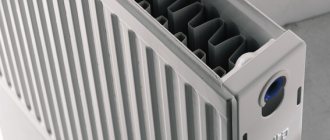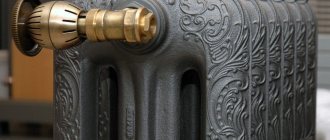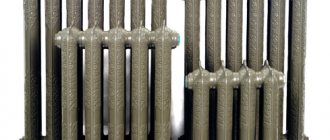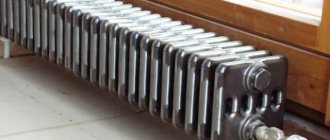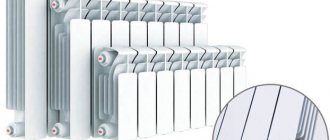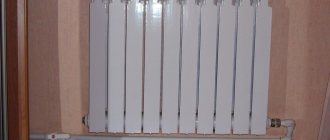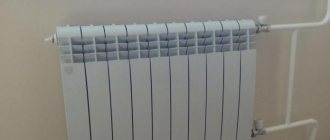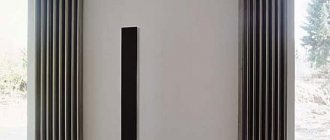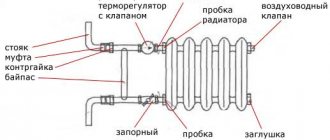Low heating radiators are in any group of heating devices. This category includes equipment whose height does not exceed 45 cm. Such small batteries are usually looked for for aesthetic reasons: with panoramic glazing or low window sills. Sometimes it is necessary to heat the entire cold wall, in which case this is one of the most effective options. After all, low radiators have low heat transfer, which means that their length will be considerable, which is what is needed to heat a cold or "weeping" wall.
It is clear that you want everything to look stylish, but in heating one cannot focus only on aesthetics: technical data are also very important. Therefore, they pay attention to the metal from which they are made. After all, it is precisely its properties that largely determine the characteristics of radiators and their area of application.
Aluminum
The lowest aluminum radiators are 245 mm high. The Sira campaign has such models: Alux 80 and Alux 100, Rovall 80 and Rovall 100, Swing. They have a good heat transfer for such miniature products - 89-97 watts. Global has a low radiator - model Gl-200/80 / D. This model is cast, with a working pressure of 16 bar.
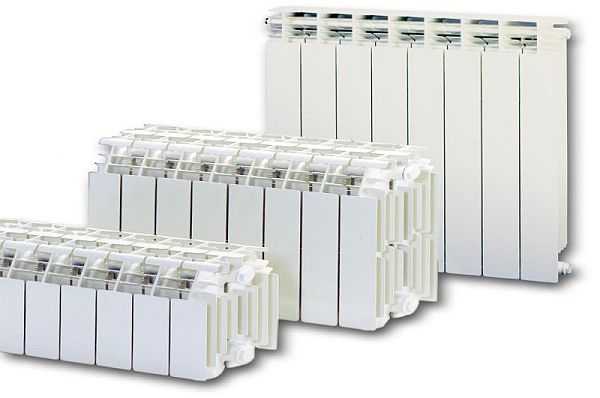
The lowest radiator at Global Gl-200/80 / D has a height of 200 mm
There are aluminum radiators with a center-to-center distance of 200 mm and from the Russian manufacturer - from] Rifar (Rifar) [/ anchor] - these are Rifar Base 200 and Rifar Forza 200. And the back wall is solid. They can be safely put "back" to the window and not worry about the appearance from the street.
But these are the smallest radiators. There is a large selection of models, the height of which will not be higher than 45 cm. Every company has such dimensions, in almost every line. The center distance of 300 mm, 350 mm or 400 mm is also suitable for the low category.
Advantages, disadvantages
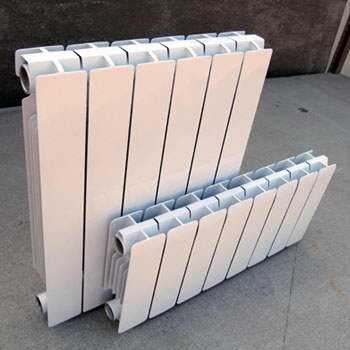

In any line there are low batteries, with a center distance of 300 or 350 mm
Advantages of aluminum radiators: lightweight, have high heat transfer, small capacity (little water is placed), quickly respond to temperature changes.
The most important disadvantage is the reactivity of aluminum and its softness. For normal and long-term operation, a high-quality heat carrier is required: Ph 7-8, operating pressure - from 5-6 Bar for extrusion models, up to 10-12 for cast ones. It is imperative that the coolant contains a small amount of oxygen and suspended matter. Oxygen contributes to the oxidation and destruction of aluminum, and suspensions grind off the metal.
But each manufacturer has its own requirements. For example, Chinese Radena aluminum radiators operate at 16 bar pressure and a heating medium with a Ph of 6.5-9. And the Sira extrusion models have an operating pressure of 16 Bar and a warranty period of 25 years. Perhaps there are other aluminum radiators whose characteristics go far beyond the average: there are too many manufacturers and models here.
When choosing, do not forget about all these technical subtleties: only if the operating conditions coincide with the recommendations of the manufacturers, the heating will work for a long time and without interruptions.
When installing the system, it is worth remembering that aluminum cannot be directly connected to copper (or copper-based alloys). This means that when wiring with copper pipes, it is better to install other radiators. Also, do not use bronze or brass fittings. Galvanized fittings and fittings work well with aluminum.
Application area
Scope: in individual heating there are practically no restrictions, you just need to pay attention to the temperature of the coolant, especially if there is a coal or wood-fired boiler in the system. It is risky to put them in apartments. Unless only very reliable and proven, and only if the coolant in the system meets the manufacturer's requirements.
Read about the choice of radiators for an apartment and a house in the article "Aluminum batteries: types, selection, connection"
main destination
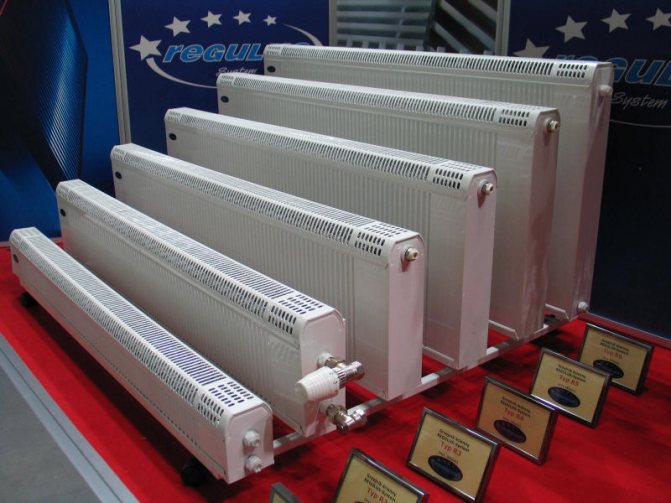

“Little kids” have a special place.
The small dimensions of the radiators were originally designed for low window sills, or their absence, hence the purpose:
- Heating of passages, halls, office premises, studios with high windows;
- Heating of winter gardens, greenhouses and other similar closed structuresin which there is no need to create a temperature of comfort, but it is required to maintain a positive temperature for the "wintering" of thermophilic and exotic plants;
- The following purpose causes a lot of justified controversy among specialists and is indicated by us for informational purposes only: for insulation of cold external and weeping walls.
For your information! Low batteries are therefore little in demand because they have low heat transfer. The price of these products is quite high + installation of all equipment, hiding pipes and other measures will cost a pretty penny.
When calculating, it turns out that external insulation of such a wall can be cheaper than installing equipment, periodically replacing fittings, the batteries themselves + paying for heat. The only justification for the demand is placement in a house where outdoor insulation is prohibited - the house is an architectural monument.
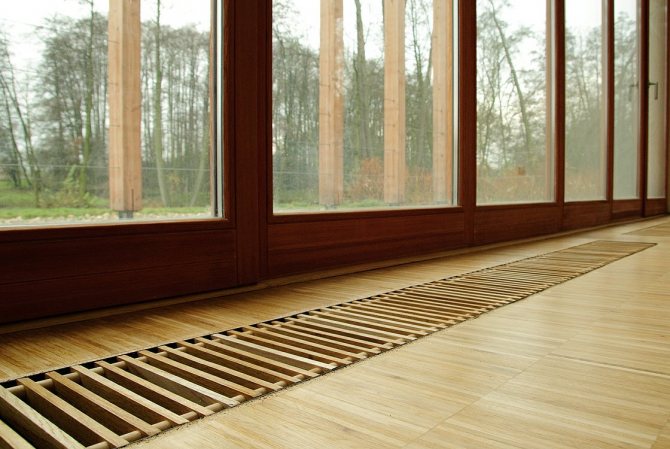

Products, of course, can be hidden in a niche, but this is not advisable.
Talking about species.
Heating radiators with a height of 200 mm can be:
- Aluminum;
- Bimetallic;
- Cast iron;
- Steel - tubular and panel;
- Copper-aluminum.
Aluminum
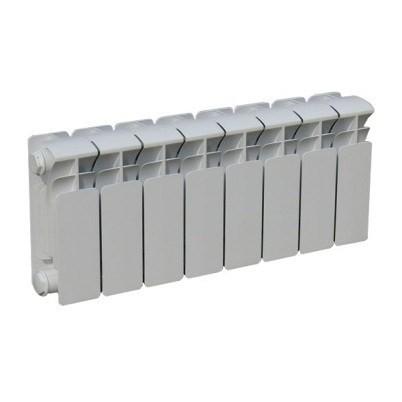

Photo of an aluminum radiator.
Aluminum radiator 200 mm has a set of qualities that will make it stand out among its congeners
| pros | Minuses |
|
|
Note! These heaters are highly not recommended to be installed in houses, especially if the boiler is solid fuel, where the heating temperature of the coolant is very difficult to control.
Bimetals are a sign of solidity
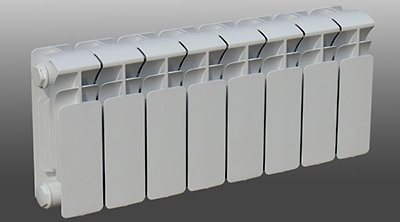

Even outwardly you cannot distinguish the material of the products.
Like any heating radiator - 200 mm - an analogue made using this technology is considered reliable and time-tested. It also has a number of features worth mentioning.
| pros | disadvantages |
|
|
Our help! Although it is believed that these radiators were developed for systems in high-rise buildings, they also performed well in private houses.
Cast iron is a product of history
Low heating radiators 200 mm high outwardly resemble the very "accordion", however, it is difficult to "unfold the furs" in small sizes, therefore they are made in design options.
A new-old product has a number of features that have features in some cases with a plus sign, in others with a minus:
- Cast iron is thick-walled, so it heats up and cools slowly. You want to quickly heat up the room, nothing will come of it, but it will smooth out temperature fluctuations due to the rate of heat release;
- Such radiators are reservoirs with liquid, in order to pump it, powerful pumps are required, but if there is a natural circulation of water, there is nothing wrong with that.
Attention! You can safely use these batteries anywhere: at home, in country cottages, etc.The main thing is to carry out timely cleaning, and the products will work for a long time.
Steel in heating
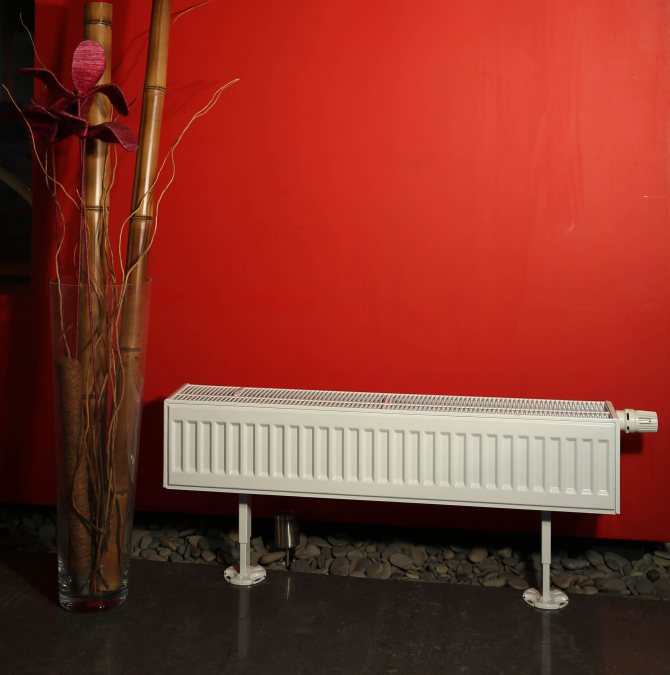

Steel products.
These radiators are perfectly adapted to private cottages and small houses. In terms of price-quality ratio, they are the best today for small closed heating systems.
And although the advantages and compatibility have become known to everyone, it's better to talk about the disadvantages:
- A 200 mm heating radiator made of steel is susceptible to corrosion, which, although it will visit it in 20 years, but what to be, it cannot be avoided;
- The circulation system of the heater must be of an exclusively closed type.
Copper and aluminum in one
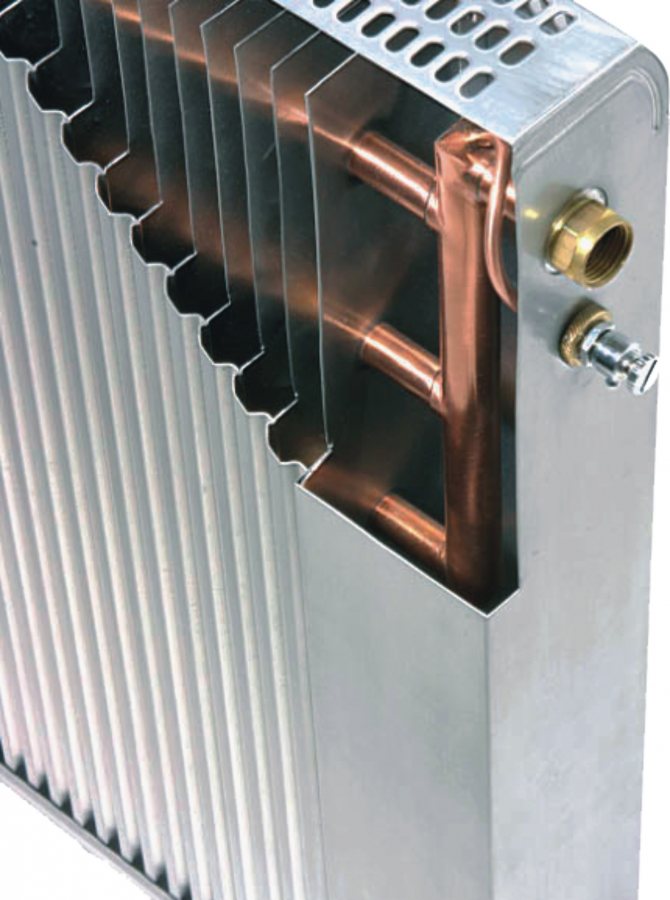

Material combinations also occur.
Although it is believed that these materials are not very compatible with each other, the developers have taken a workaround by building hybrids from a copper tube and aluminum plates. At the same time, copper takes on the aggression of hot water, pressure, and aluminum quickly heats up and quickly gives off heat.
But here, too, there are some nuances.
Radiators with a height of 200 mm, of course, will work and have the declared advantages, but:
- Although copper can withstand pressure more than household pressure, it is a soft material and is vulnerable to suspensions in water - it is erased;
- Solder, which combines copper and aluminum, does not tolerate sudden increases in temperature, leaks are possible;
- Copper is one of the materials that perfectly reproduce sounds. If you are a “happy” owner of a domestic hybrid, be prepared for a kind of rustle and sound in the radiators, this is normal.
For your information! These radiators feel great with metal polymer pipes and boilers, where the heating parameters are automatically regulated.
Bimetallic
It is customary to call heating devices bimetallic radiators, in which the collectors, through which water flows, are made of steel (sometimes stainless, sometimes black). This frame is then fused with an aluminum "jacket" of fins (to increase heat transfer).
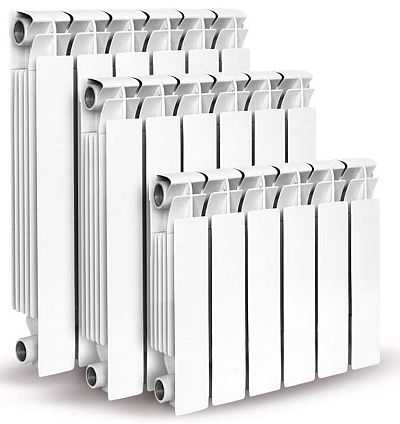

Bimetallic very small radiators do not
Such batteries have a high operating pressure - up to 20-24 bar, can work with almost any coolant (stainless steel collectors work with any), have a fairly high heat transfer. Their disadvantage: often a small cross-section of vertical sea otters, as well as a high price.
The situation here is practically the same as in aluminum ones: some manufacturers have very small radiators with a height of 245-265 mm (the same "Syrah" and "Rifar" have them), and almost all of them have heights from 350 mm to 450 mm.
Advantages, disadvantages
Advantages - high working pressure, compatibility with any metals (aluminum does not come into contact with either the coolant or the supply pipelines). Works with a heating medium in a wide range - Ph 6.5-9 in models with steel collectors and Ph from 5 to 10-11 in models with stainless (Royal Thermo, Calidor, Nova Florida, Radena). Another good quality is the high heat transfer of the section, as well as low inertia (allows you to accurately regulate the temperature in the room using the boiler automation or the temperature controller for the radiator).
Disadvantages - high price, which is due to the high complexity of the technology. And one more drawback: some companies make vertical collectors of small diameter, and they, with a high content of suspended particles in the coolant, can clog. Therefore, it is desirable to install filters at the entrance (and they need to be cleaned regularly).
Application area
This type of radiator has been specially developed for our central heating conditions. Therefore, they need to be installed in high-rise apartments. They will work great in individual heating, but why pay a lot of money for an unnecessary safety factor (almost tenfold)?
Vertical batteries
Models with a vertical orientation are seen much less, and are much more often available in stores only on order. This is due to the fact that such products are used, for the most part, for extraordinary interiors.
From a technical point of view, vertical orientation is disadvantageous, since the heated air space is located at the top, which reduces the rate of heat transfer. In addition, the activity of convection decreases, the warmed masses accumulate under the ceiling.
The artistic value of batteries with a vertical installation does not cause any doubts: quite often you cannot do without them, especially in rooms with columns, high windows on the entire wall, a huge number of openings and niches in the walls.
But such interiors are seen only in rich buildings, based on this, the price of vertical models is high, and the popularity among the masses is low.
Note! Vertically oriented heaters are much more likely to solve purely artistic tasks and are not widely used.
Cast iron
Long gone are the days when there was only one type of cast iron batteries. The "Soviet" accordion is far from the only option, there is also a modern style, and in a palace, and in a modern style. There are wall and floor models. Wall-mounted ones are basically the same "accordion" - MS-140 and others, as well as the usual sectional ones of the style familiar today. Floor standing - more often referred to as design radiators. And, unfortunately, they cost a lot. But they look stylish. Read about the types and types of radiators, their manufacturers and technical characteristics here.
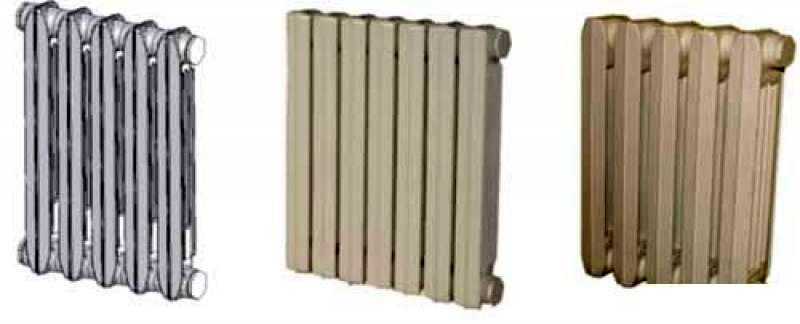

Cast iron radiators today are also in a modern style.
"Accordion" is also produced today, and it is in good demand. Called MS-140, MS-110 and MS-90. There are also low models here: with a center distance of 300 mm, and an installation height of 382-388 mm (the height is slightly different for different manufacturers).
There are cast iron radiators in a modern style: they look very much like aluminum and bimetallic ones. In this group, the smallest radiators will also be slightly less than 400 mm.
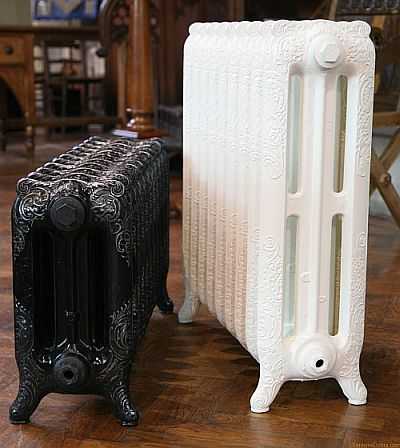

Retro style cast iron radiators are often small
And the third group of cast iron batteries is the design of radiators. Most of them are floor-mounted - on legs. And their sizes are also about the same: around 40 cm (with legs). But some firms have very compact ones:
- BOLTON 220 model with an installation height of 330 mm;
- The Hellas 270 from Viadrus is only 340 mm high.
Perhaps there are other low cast-iron radiators: there are a lot of different proposals, it is impossible to track everything.
Advantages, disadvantages
The undoubted advantages are a long service life, a low price (except for design radiators) and the ability to work with any coolants. Disadvantages - large mass and fragility, difficult to process, not repaired, low operating pressure - 9-10 bar.
There are also properties, which in one case are an advantage, and in the other - a disadvantage:
- Great inertia. Thick walls take a long time to warm up when the system is overclocked. But they cool down for a long time. This feature allows them to smooth out temperature fluctuations when using a conventional coal boiler.
- Large section sections. They hold a lot of water, which again leads to increased system inertia and the use of a more powerful pump in systems with forced circulation. But for systems with natural circulation, low hydraulic resistance of wide collectors is a definite plus.
Application area
All these properties determine the area of use of cast iron radiators, including low ones: they are optimal for individual heating systems (houses, summer cottages, cottages). They stand quite well in high-rise buildings of small storey: where the working pressure in the system does not exceed 9-10 bar. They do not impose other requirements on the coolant: they do not care whether there is oxygen, how much suspended matter it contains, and what its acidity is. With periodic washing, they will stand for a long time.
Read how to flush the battery here.
Steel tubular
This category has the largest assortment of low radiators. And the low ones here are:
- from 150 mm in height for Purmo - Delta Laserline model;
- from 180 mm, Arbonia has almost all models of the "standard" range, there is also a radiator-bench with a height of 180 mm;
- from 190 mm for Zehnder, model Charleston and bench radiators from 400 mm and 410 mm.
- With a center distance of 300 mm from the Russian KZTO.

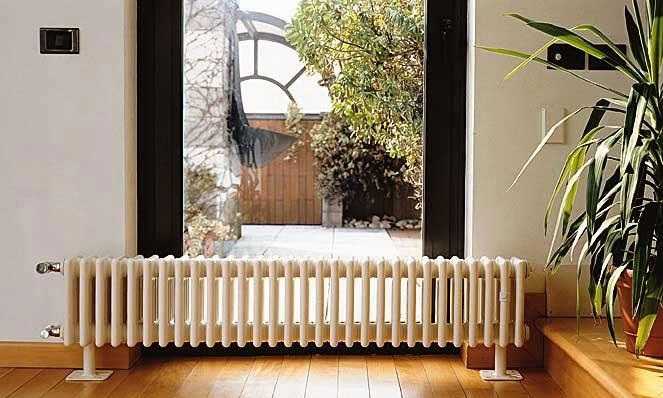
Tubular radiators are very decorative
At any manufacturer of tubular radiators, you will find those that can be classified as low. They can have from two to six columns of pipes, respectively, they will have different depths - from 50 mm to 250 mm. Each of the models can be installed on the floor or hung on the wall (specify when ordering).
Advantages and disadvantages
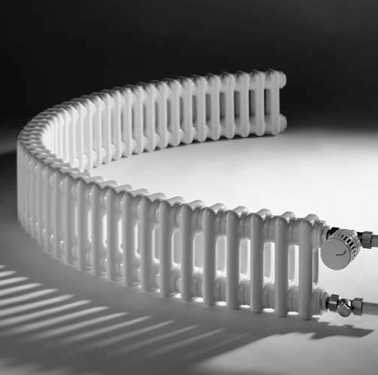

Tubular radiators can be non-linear
The advantages include a large selection of models, with different widths and depths, ease of cleaning, attractive appearance, a large number of decorative options. A large cross-section of pipes creates a small hydraulic resistance, moreover, such radiators are rarely clogged.
Disadvantages are due to steel: tendency to corrosion, high requirements for the coolant, low operating pressure, short service life - from 5 to 10 years. Exception - Zehnder Charleston Pro
, which is processed from the inside with two compounds. They resist corrosion so well that this option can stand at Ph 5-11. The warranty period is 25 years.
Application area
Basically, tubular radiators are designed for individual heating. Moreover, they can work both in systems with forced and natural gravity. The only requirement is that the system must be of a closed type.
Heating radiators
The radiator is one of the main heating elements for any room. There are several types of heating radiators: steel, aluminum, bimetallic and cast iron. For each heating system, be it a central (city) or private boiler room, its own type of radiators is suitable. For private houses, aluminum sectional or steel panel radiators are best suited. These radiators are designed for low pressure and have high heat dissipation. Also, they are not destroyed under the influence of antifreeze, which can be used as a coolant in private boiler rooms.
For urban systems, bimetallic models are most suitable. The main distinguishing feature of bimetallic radiators is that they consist of two metals, steel and aluminum, namely: inside the aluminum shell there is a steel core. It is thanks to this technology that the destruction of the radiator does not occur under the influence of the aggressive alkaline medium of the central heating system.
Steel tubular or cast iron radiators are best suited for the decoration of an exquisite design in the premises of your country house. Steel tubular radiators have an interesting nostalgic design and have a wide range of colors and can be made in almost any size. Tubular radiators can also be installed in the central heating system, but the parameters of the operating and pressure pressure should be checked with the house management company.
Modern cast iron radiators are decorated in a unique design with original decorative molding technology, but due to the small thickness of the material of manufacture, they can be used only in country houses.
If you have high panoramic glazing in your room, then you should pay attention to the convectors built into the floor. The convector consists of a steel body and a copper heat exchanger. There is also a wide range of decorative grilles for them. Available with forced convection (with built-in fan) and natural convection (without fan). This type of radiator is perfect for a modern country cottage or apartment with low pressure in the heating system.
You can find information on all the radiators listed above on the pages of our website, and our specialists will help you choose the right radiators for you.
Steel panel
Steel panel radiators are low: they are mainly made from 300 mm in height (here it is the height of the radiator, not the center-to-center distance). Any manufacturer has them: both the Russian Prado and the European Purmo and Kermi.
There are also lower ones, but they are rare. So] Purmo [/ anchor] has the Ventil Compact, Purmo Planora and Ramo Compact models. Their height starts from 200 mm (center distance 150 mm). We did not find any other so small.
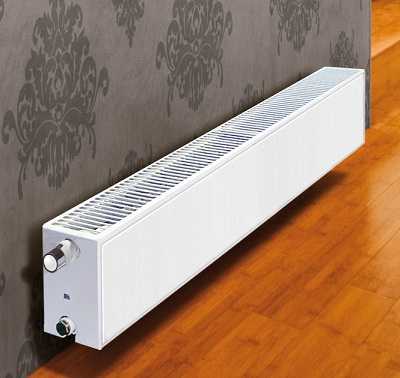

Steel panel radiators are very low
Advantages and disadvantages
The advantages of steel radiators include their compact dimensions and the lowest price of one kilowatt of power. In addition, steel is a non-capricious metal that does not conflict with other components of the system.
The main disadvantage is the tendency to corrosion, and hence the exactingness to the coolant: Ph 7-8 and the lack of oxygen (closed systems). The walls of the panels are 1.25 mm or 1.4 mm thick. With a coolant of poor quality, they can corrode in several seasons. There is one more disadvantage, which is due to the design: the small width of the channels through which the coolant circulates. With a large amount of contaminants in the coolant, they quickly become clogged. And flushing such a radiator is a problem. Another disadvantage is the difficulty of cleaning in the presence of plates with convective ribs.
Read more about steel radiators here.
Application area
Normally, panel radiators are in individual closed-type systems (with a closed expansion tank). The circulation of the coolant must be forced: these heaters have a high hydraulic resistance.
They are not recommended to be installed in high-rise apartments, the pressure rarely allows this (working 10 bar). Only in systems that have their own water treatment (independent type of connection) with a mandatory deaeration (air removal) stage.
The best of the best…
Now let's give some examples. We decided to find out which heating radiators have the largest (or, conversely, the smallest) values of the discussed parameters. Here's what we got:
- The lowest radiator - Purmo Ventil Compact 200 - has a total height of 200 mm and a center-to-center distance of 150 mm. At the same time, its heat transfer is quite serious - to obtain a heating power of 1.5 kW, it is necessary to install a type 22 device with a length of 1 m 60 cm;


Purmo Ventil Compact 200 - The highest radiator of the serial models - Arbonia 2180 or 3180 - their height is 1 m 80 cm. If you wish, you can install an even larger battery - radiators with vertical dimensions up to 3 meters are supplied on request;
- The flattest radiators are Prado Universal type 10, its depth is only 48 mm. Such a battery with a height of 500 mm and a length of 1 m 60 cm provides a heat transfer of slightly less than 1.3 kW;
- The narrowest radiator is Arbonia again. The 6-section model with a height of 1 m 80 cm is only 270 mm long. Moreover, it is quite enough for heating a room of 12 square meters.
Copper-aluminum radiators
This type of radiators and convectors, with small dimensions, has a high heat transfer. Usually it is a copper tube on which aluminum plates are fixed. This device is hidden in a painted steel casing (sometimes found in stainless steel). Most of the manufacturers on the market produce low copper-aluminum radiators:
- "Thermia" - height from 200 mm, bottom and side connections.
- Regulus-sistem - all models with a height of 215 mm;
- "IsoTerm" - from 215 mm;
- Mars - sectional type with a height of 385 mm.
Read about the manufacturers and models of copper-aluminum and copper radiators here.
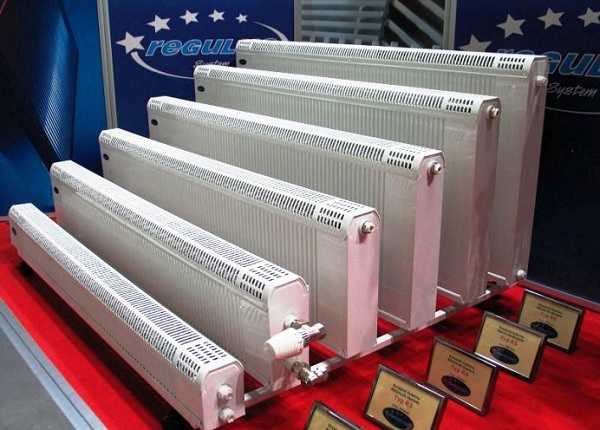

Pictured are copper-aluminum radiators Regulus-sistem
Advantages, disadvantages
The advantage of this type of low radiator is a rather large heat transfer at a small size (a 200mm * 400mm radiator produces 240W). The second good property is that copper does not require a closed system, and Ph should be in the range of 7-9. Quite high working pressure - 16 bar.
But, despite such characteristics, it is not recommended to install in systems with centralized heating: if copper itself reacts little to the quality of the coolant, then it corrodes the solder and leaks appear at the soldering points. And, in addition, copper is incompatible with some metals, and also reacts poorly to a large content of abrasive particles that simply wear it away (copper is soft and gradually grinds off, and this is one of its main disadvantages). Another drawback is the high price, as well as squeaks and rustles that occur when cooling and heating radiators (but this is only for domestic models, European manufacturers have learned to deal with this, ours, not yet).
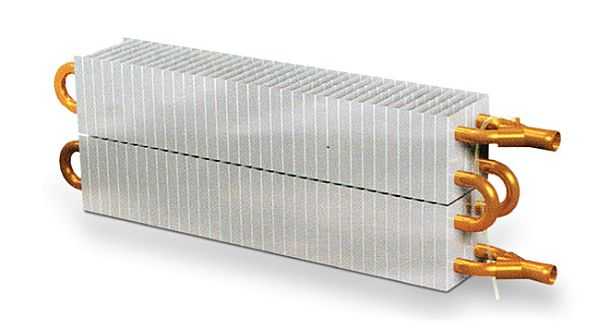

Inside the copper-aluminum radiators there is such or a similar structure.
Application area
And again, these radiators will fit well in individual systems (with forced circulation). But the wiring is desirable from copper, polymer or metal-polymer pipes. In apartments, low copper-aluminum radiators will work normally, provided that the requirements for the coolant and working pressure are met. It is also necessary to install a filter at the inlet.
Skirting heating
This type of heating devices appeared in our country not so long ago. These are very similar devices to copper-aluminum radiators: the same copper tube on which copper or aluminum convective plates are put. They just have a different connection method, layout and other dimensions. Heating elements can be inserted into heating modules (tubes with plates) or they can be assembled into closed circuits through which the coolant circulates. They are located along the floor along the perimeter of the walls, covered with metal decorative overlays. In width - about 3 cm, in height 12-20 cm, depending on the power. Precisely low radiators.


This is what plinth heating looks like. No more other heaters
Advantages, disadvantages
The advantage is that most of the heat (70-80%) is transferred by thermal radiation. From the heat that rises from warm skirting boards, the walls are heated first. They then begin to radiate heat. Therefore, a more uniform temperature is observed in the room, and warm air does not accumulate at the top.
Another plus is the very compact size and at the same time quite high heat transfer: one meter produces 180-280 watts at average temperatures. In addition, they are not striking and provide a wide scope for design decisions.
Minus one - high price.
Application area
They are excellent in individual heating systems. It is possible to install electric warm skirting boards in the apartments. Connecting to centralized heating requires a complex system: for optimal operation, the difference between the supply and return pipelines should not exceed 5oC, therefore each circuit should be no more than 12-14 meters long, and a mixing unit must be installed to maintain normal temperature.
Narrow radiators
Varieties


An example of modern design using a narrow radiator.
The definition of "narrow" appears to be rather streamlined and vague, so some clarity is needed.
Let's start with the fact that not only the horizontal, but also the vertical projection of the product can be called narrow, so we get two groups:
- Narrow horizontal devices, in which the height is much less than the width, that is, a horizontal projection of the case is considered;
- Vertical instruments, in which the width is much less than the height, and the object of consideration is the vertical projection of the body.
Important! Vertical and horizontal batteries are used in different ways and solve different technical and design problems.


Narrow horizontal model.
This group of convectors can be subdivided on the basis of the generally accepted classification, so we can safely distinguish the following varieties:
- Tubular registersmade of steel, copper or cast iron. The design is a system of vertical or horizontal pipes connected by manifolds, it is very popular in a narrow-profile design;
- Sectional cast iron batteries... This is a familiar model for residents of post-Soviet cities, which is also very popular in the production of non-standard products;
- Finned sectional convectors... These are modern aluminum or bimetallic devices with characteristic vertical plates;
- Steel panels... They are welded profiled steel plates that form internal channels due to profiling. The coolant circulates through the channels and heats the panel.
Important! Each type of construction has its pros and cons, therefore, when designing a heating system with your own hands, it is better to read individual articles on our website dedicated to the types of radiators.


There are non-standard types of models.
Among other things, narrow convectors can be made of various materials. The material used also greatly affects the efficiency of the device, so this factor should be taken into account.
Today, batteries are produced from the following metals:
- Cast iron;
- Steel;
- Aluminum;
- Copper;
- Steel + aluminum;
- Copper + aluminum.
The highest heat transfer is observed in copper and aluminum products, however, the former are too expensive, and the latter are demanding on the coolant and pressure in the system. Steel devices are afraid of water hammer and corrosion, cast iron ones are too heavy and inert.
A bimetallic steel-aluminum radiator is considered a compromise solution.


The heat dissipation efficiency depends on the housing material.
Important! The classification and differences in the types of devices do not depend on their size and are made according to general rules.
Appointment


The non-standard form solves technical and artistic problems.
Let's talk about the purpose of narrow heating devices. Why are they needed?
The fact is that it is far from always possible to successfully fit standard products into the interior, especially in modern apartments and houses. As you know, it is customary to install radiators under windows, but modern trends tend to increase window openings, and the usual batteries simply do not fit on the window sill.
Often the window takes up the entire height of the wall. In this case, underground convectors are mounted, or a high and narrow radiator is placed next to the window, which solves the problem of heating this area of the house.
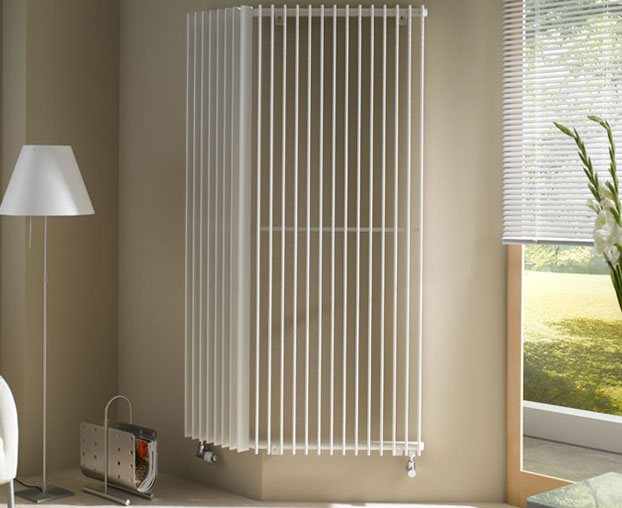

Vertical battery by the window.
Often there are houses with non-standard design layouts that do not involve the usual placement of batteries. In this case, heaters can be installed in special niches, on walls or in corners.
Rooms in bathrooms and toilets, as well as kitchens and hallways, often have unusual shapes and sizes. Here it also turns out to be appropriate to use convectors with narrowed dimensions.
Finally, it often happens that the device itself of an unusual shape becomes an accessory and decorates a room, shapes its style and creates a certain atmosphere. In this case, its application is purely artistic.
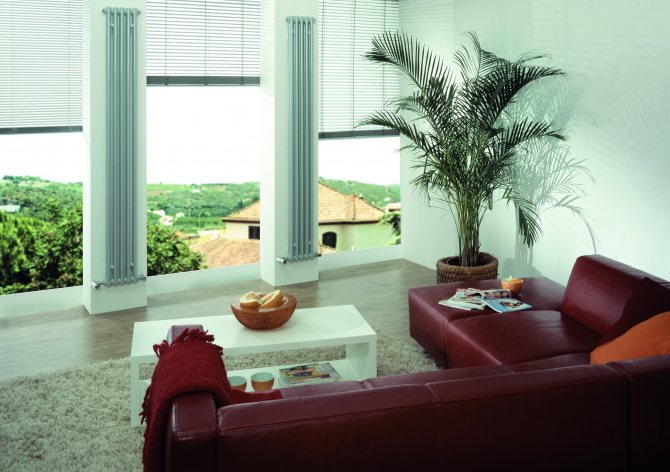

Sometimes the instruction assumes the use of columns for mounting batteries.
Important! The use of narrowed radiators is due to the fact that standard devices do not fit or do not fit well into the interior, as well as due to the design delights of the architect. Typically, both reasons play a role.

